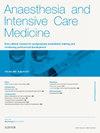Anaesthesia for carotid surgery
IF 0.3
Q4 ANESTHESIOLOGY
引用次数: 0
Abstract
Stroke is a leading cause of morbidity and mortality and may be preceded by a transient ischaemic attack (TIA). 20% will have a carotid stenosis caused by atheromatous plaque which can be removed by carotid endarterectomy, reducing the risk of further stroke.
Risk of stroke is highest in the immediate period following TIA and surgery is recommended within 7 days. The benefits of surgery are highest in those with more than 70% stenosis. Preoperative optimization is limited by the urgency of surgery, but assessment focuses on associated cardiac and respiratory comorbidities including blood pressure control.
Carotid endarterectomy can be performed under general or regional anaesthesia (with superficial or intermediate cervical plexus blocks) and while large trials have shown no significant difference in outcomes, there are advantages and disadvantages to each. Intraoperative blood pressure control and care with the effects of positioning is required. Smooth emergence with early neurological assessment is the aim with general anaesthesia. The main risk of surgery is postoperative stroke but there is no high-quality evidence for intraoperative shunting or cerebral monitoring in reducing this.
Other postoperative complications include cardiac ischaemia, hypertension including cerebral hyperperfusion syndrome and airway compromise due to oedema/haematoma.
颈动脉手术麻醉
中风是发病率和死亡率的主要原因,在其发生之前可能会发生短暂性脑缺血发作(TIA)。20%的患者会有由动脉粥样斑块引起的颈动脉狭窄,这些斑块可以通过颈动脉内膜切除术去除,从而降低进一步中风的风险。中风的风险在TIA后的短时间内最高,建议在7天内进行手术。手术的好处在狭窄超过70%的患者中是最高的。术前优化受到手术紧迫性的限制,但评估的重点是相关的心脏和呼吸合并症,包括血压控制。颈动脉内膜切除术可以在全身麻醉或局部麻醉下进行(浅表或中度颈丛阻滞),虽然大型试验显示结果没有显著差异,但每种方法都有优缺点。术中血压的控制和护理需要配合体位的作用。全身麻醉的目的是顺利苏醒并进行早期神经学评估。手术的主要风险是术后卒中,但没有高质量的证据表明术中分流或脑监测可以减少卒中。其他术后并发症包括心脏缺血、高血压(包括脑高灌注综合征)和由水肿/血肿引起的气道损害。
本文章由计算机程序翻译,如有差异,请以英文原文为准。
求助全文
约1分钟内获得全文
求助全文
来源期刊

Anaesthesia and Intensive Care Medicine
ANESTHESIOLOGY-
CiteScore
0.50
自引率
0.00%
发文量
152
期刊介绍:
Anaesthesia and Intensive Care Medicine, an invaluable source of up-to-date information, with the curriculum of both the Primary and Final FRCA examinations covered over a three-year cycle. Published monthly this ever-updating text book will be an invaluable source for both trainee and experienced anaesthetists. The enthusiastic editorial board, under the guidance of two eminent and experienced series editors, ensures Anaesthesia and Intensive Care Medicine covers all the key topics in a comprehensive and authoritative manner. Articles now include learning objectives and eash issue features MCQs, facilitating self-directed learning and enabling readers at all levels to test their knowledge. Each issue is divided between basic scientific and clinical sections. The basic science articles include anatomy, physiology, pharmacology, physics and clinical measurement, while the clinical sections cover anaesthetic agents and techniques, assessment and perioperative management. Further sections cover audit, trials, statistics, ethical and legal medicine, and the management of acute and chronic pain.
 求助内容:
求助内容: 应助结果提醒方式:
应助结果提醒方式:


